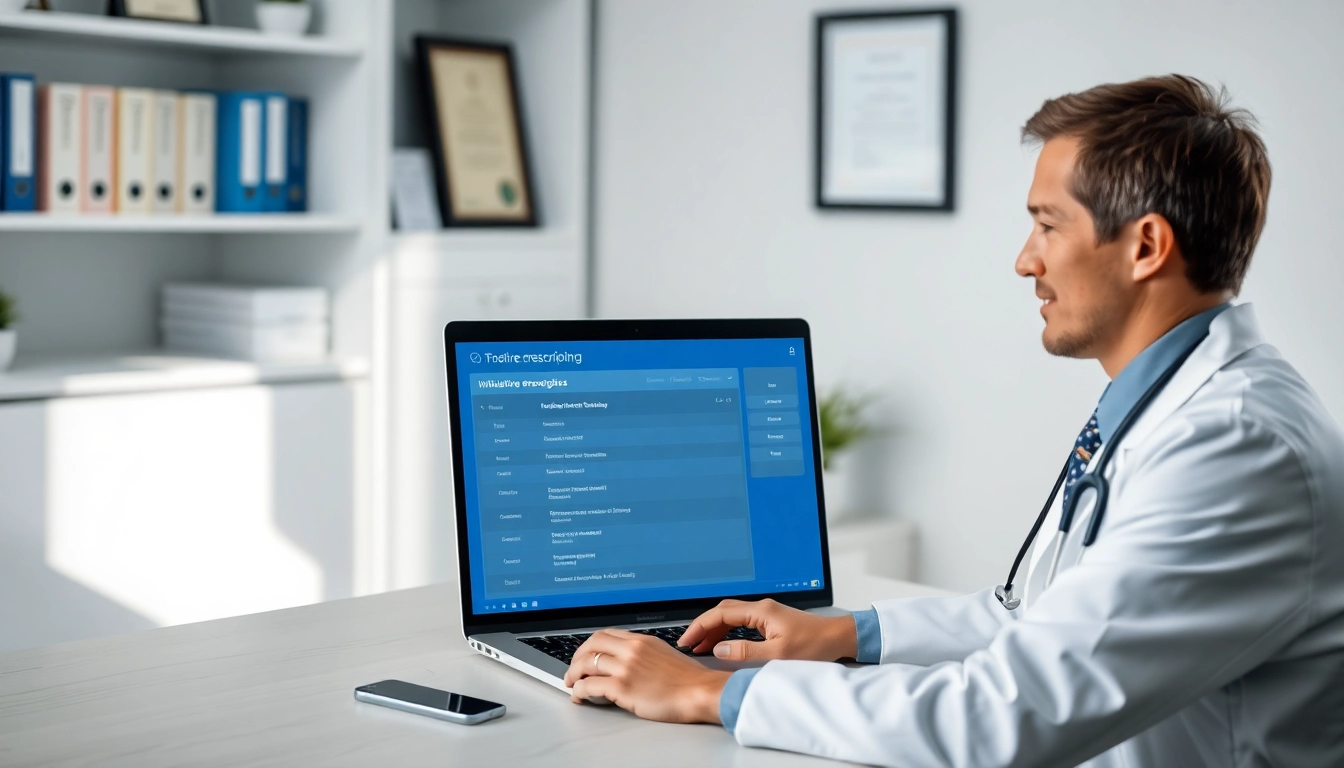Understanding the Benefits of eprescribing software
In the rapidly evolving landscape of healthcare technology, eprescribing software has emerged as a crucial tool for improving the efficiency and effectiveness of prescription management. Healthcare providers increasingly recognize the value of transitioning from traditional paper prescriptions to electronic systems, which offer a multitude of advantages in the realms of patient safety, workflow efficiency, and overall healthcare quality. This article delves into the myriad benefits of adopting eprescribing software, particularly focusing on streamlined prescription management, enhanced patient safety and compliance, and increased operational efficiency for healthcare providers.
Streamlined Prescription Management
One of the primary benefits of eprescribing software is the streamlining of prescription management. Traditional prescribing methods often involve several steps that can introduce errors, delays, or confusion. By utilizing electronic systems, healthcare professionals can easily create and send prescriptions directly to pharmacies. This minimizes the likelihood of human errors that can occur when handwriting prescriptions or interpreting drug names, dosages, and instructions.
Additionally, eprescribing software frequently includes features like medication history checks, which can alert providers to potential drug interactions before the prescription is sent. This proactive approach not only reduces errors but also promotes better-informed prescribing decisions, ultimately leading to a safer medication process for patients.
Improved Patient Safety and Compliance
Patient safety is a paramount concern in healthcare. With eprescribing software, healthcare providers can ensure that patients receive the correct medications in a timely manner. The ability to electronically prescribe medications enables practitioners to verify a patient’s profile and prescription history quickly, reducing the risk of adverse drug interactions or incorrect dosages.
Furthermore, eprescribing enhances patient compliance by facilitating automatic refills and medication reminders. Patients are more likely to adhere to their medication regimens when they receive timely notifications and reminders about their prescriptions, contributing to improved health outcomes. The integration of patient engagement tools within eprescribing platforms can further empower patients to take an active role in their healthcare, leading to better adherence and recovery rates.
Increased Efficiency for Healthcare Providers
In addition to enhancing patient safety, eprescribing software significantly increases overall efficiency for healthcare providers. The traditional method of managing prescriptions can be cumbersome, requiring lengthy phone calls and faxes to pharmacies, as well as dealing with potential discrepancies and delays.
With an electronic system, practices can reduce the time spent on administrative tasks and streamline workflows. The easy accessibility of records means that healthcare providers can quickly review and process medication orders, improving their productivity. This efficiency not only benefits the practitioners and their support staff but also leads to reduced patient wait times and a smoother patient experience.
Key Features to Look for in eprescribing software
As healthcare practices consider adopting eprescribing software, it is vital to identify key features that will best meet their needs. Not all eprescribing platforms are created equal, and selecting the right software can make a significant difference in terms of usability, functionality, and compliance. The following sections outline pivotal features to consider when evaluating different eprescribing software solutions.
User-Friendly Interface
A user-friendly interface is essential for any software implementation, especially in the high-pressure environment of healthcare. Practitioners need software that is intuitive and easy to navigate, allowing for quick learning and efficient use. A complex system can lead to frustration among staff, potentially causing them to revert to less efficient paper methods.
Look for software solutions that prioritize usability, featuring clear icons, organized menus, and straightforward workflows. Ideally, a user-friendly system will provide comprehensive training and support, helping to ensure all team members are comfortable utilizing the software to its fullest potential.
Integration with Electronic Health Records
Seamless integration with Electronic Health Records (EHR) is another critical feature of effective eprescribing software. An integrated system allows healthcare providers to access patient data and medication histories directly within the same platform, streamlining workflows further and reducing the need to switch between multiple applications.
This integration facilitates better communication among healthcare providers, allowing for collaborative care and holistic patient management. When providers can easily access a patient’s complete health information, they can make more informed prescribing decisions, address potential reactions, and customize treatment plans based on comprehensive data.
Compliance with Regulatory Standards
Compliance with regulatory standards and security requirements is non-negotiable in healthcare technology. Selecting eprescribing software that adheres to local and national regulations—including data privacy laws and electronic prescribing standards—is essential to maintaining the integrity of patient data and ensuring safe prescribing practices.
When evaluating a software solution, look for certifications that indicate compliance with the Drug Enforcement Administration (DEA) or other relevant organizations. Ensuring that the software meets these standards not only protects patients but also shields healthcare providers from potential legal issues and penalties.
Implementing eprescribing software in Your Practice
The decision to implement eprescribing software is just the beginning; successfully integrating it into a healthcare practice requires careful planning and execution. A seamless implementation process can significantly mitigate disruptions and foster acceptance among staff and patients alike. Below are several steps towards effective implementation.
Step-by-Step Implementation Guide
Implementing eprescribing software involves several critical steps:
-
Assess Needs and Goals:
Before selecting a software platform, assess the specific needs of your practice. Identify pain points in your current prescription process and outline your goals for the new system.
-
Choose a Software Solution:
Based on your needs assessment, evaluate and select software that offers the features and capabilities you require. Consider conducting demos or trials to gauge usability and fit.
-
Prepare the Practice:
Ensure that the necessary infrastructure (e.g., internet connection, devices) is in place to support the software. Inform the entire team about the impending change and outline how it will benefit the practice.
-
Training and Onboarding:
Provide thorough training to all staff. This may involve a combination of sessions led by software representatives and internal workshops to reinforce learning.
-
Go Live:
Once training is completed, switch over to the new system. Monitor progress closely and remain available for support as staff navigate the initial adjustment period.
-
Evaluate and Optimize:
After implementation, regularly evaluate the performance of the eprescribing software. Gather feedback from staff and patients to identify areas for improvement and optimization.
Training Staff on the New System
Staff training is pivotal to the success of any new software implementation. Effective training ensures that every team member feels competent and confident in using the new eprescribing software. Consider the following strategies:
- Conduct Hands-On Workshops: Interactive training sessions can engage staff and allow them to practice using the software in real-time.
- Offer Resources and Support: Provide access to user manuals, video tutorials, and a dedicated support channel to help staff when questions arise post-training.
- Encourage Team Collaboration: Pair more experienced users with those who may struggle, fostering a culture of support within the team.
Monitoring and Evaluating Performance
After the successful launch of your eprescribing software, continuous monitoring and evaluation are essential to ensure that the system meets the practice’s expectations and needs. This includes:
- Tracking Prescription Errors: Monitor for any increase in prescription errors post-implementation to identify any areas that may need refinement.
- Collecting User Feedback: Regularly gather feedback from staff and patients to detect any usability issues or desired features that may improve functionality.
- Adjusting Workflows: Be willing to refine workflow processes as needed, based on the insights gathered during the monitoring phase.
Common Challenges and Solutions for Using eprescribing software
While the benefits of eprescribing software are significant, healthcare practices may encounter various challenges during adoption and use. Understanding these issues and preparing to address them can smooth the transition and enhance overall satisfaction with the system. Below are some common challenges and suggested solutions.
Addressing Technical Issues
Technical issues can arise during the implementation of new software, leading to frustration and resistance among staff. Common problems may include software bugs, connectivity issues, or complications during integration with existing systems. To mitigate these issues:
- Invest in Reliable IT Support: Ensure your practice has access to skilled IT support who can address technical issues swiftly to minimize disruption.
- Choose Reputable Software Vendors: Select software from vendors with a proven track record in the healthcare industry and positive user reviews.
Ensuring Data Security and Privacy
Data security is paramount in healthcare, particularly with regards to sensitive patient information. Practices must take proactive measures to ensure that their eprescribing software complies with security regulations, such as HIPAA. Strategies include:
- Regular Security Audits: Conduct security audits to identify potential vulnerabilities and enhance protections against data breaches.
- Train Staff on Data Protection: Provide ongoing training for staff on data security best practices, emphasizing the importance of protecting patient information.
Overcoming Resistance to Change
Resistance to change is a common challenge when implementing new technology. Some staff may feel comfortable with existing methods and hesitate to adopt new ones. To foster acceptance and enthusiasm for the new system:
- Communicate the Benefits: Clearly articulate how the new system will improve workflows and patient care. Engaging staff in discussions about the software can address concerns and build excitement.
- Involve Staff in the Decision-Making Process: Involve key team members in the selection and implementation process to cultivate a sense of ownership.
Future Trends in eprescribing software
The world of healthcare technology is constantly evolving, and eprescribing software is no exception. As innovations emerge, practices must stay ahead of the curve to maintain efficiency and provide the best possible care. Below are some anticipated trends that are likely to shape the future of eprescribing software.
Artificial Intelligence in Prescription Management
The integration of artificial intelligence (AI) into eprescribing software is poised to revolutionize the way prescriptions are managed. AI can analyze patient data and treatment outcomes, providing healthcare providers with intelligent insights that can support clinical decision-making. By identifying patterns and potential issues, AI-powered solutions can enhance medication safety and optimize prescriptions based on individual patient needs.
Expanding Telehealth Capabilities
The rise of telehealth has transformed patient care, allowing for remote consultations and provision of services. As telehealth continues to grow, eprescribing software will adapt to support virtual visits. This integration will enable seamless communication between patients and providers, allowing prescriptions to be sent electronically following telehealth consultations, improving access to medications for patients regardless of location.
Enhancements in Patient Engagement Tools
The future of eprescribing software will increasingly focus on enhancing patient engagement tools. With the rise of digital health literacy, patients are becoming more proactive about their healthcare decisions. Software that incorporates features such as prescription management tools, education resources, and communication platforms will empower patients to take charge of their medication adherence and overall health.
In conclusion, adopting eprescribing software represents a transformative opportunity for healthcare practices seeking to improve patient care and operational efficiency. By understanding the benefits, selecting the right features, overcoming challenges, and staying informed about future trends, healthcare providers can successfully implement this technology and pave the way for a more streamlined and secure prescribing process.



